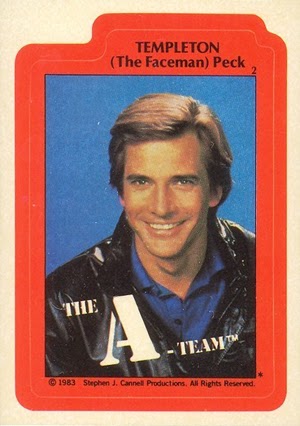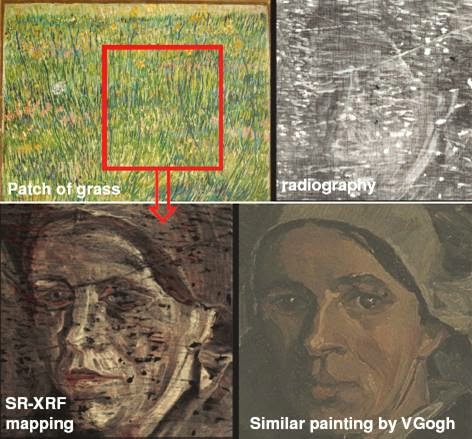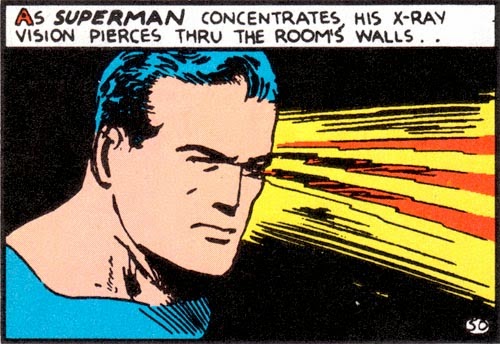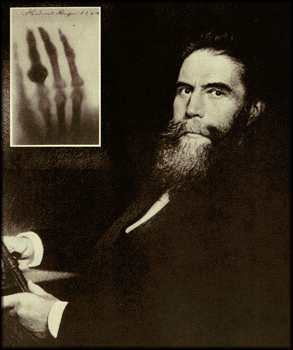Yes, I was a big fan of the A-Team. Who wasn’t? Mr. T (I guess that makes me Prof. T…) was always entertaining to watch. Lieutenant Templeton Arthur Peck was suave, smooth-talking, and hugely successful with women. Peck served as the team’s con man and scrounger, able to get his hands on just about anything they needed. Need a refresher? Have a peek here.
Well in a past post 2 Legit 2 Quit we talked about why we assess validity – because we want to know the nature of what is being measured and the relationship of that measure to its scientific aim or purpose. So what if we are uncertain that our measure (a scale for example) looks reasonable? We would consider face validity and content validity. Essentially, face validity assess whether or not the instrument we are using to measure appears to be assessing the desired qualities or attributes based on “the face of it”. Content validity – that was touched on in the previous post – is closely related and considers whether the instrument samples all of the relevant or important content or interest.
So, why the importance of face validity? Whenever you need to interact successfully with study participants there is often a need to:
– increase motivation and cooperation from participants for better responses.
– attract as many potential candidates.
– reduce dissatisfaction among users.
– make your results more generalizable and appealing to stake holders.
These are especially important points to consider when planning a study that involves human subjects as respondents or there exists any level of subjectivity in how data is collected for the variables of interest in your study.
 However, you want to avoid a “Con Man” situation in your study where respondents’ answers are not what they appear to be. As a researcher you need to be aware that there may be situations where Face Validity may not be achievable. Let’s say for instance you are interested in discovering all factors related to bullying in high school. If you were to ask the question ‘ have you ever bullied a classmate into given you his/her lunch money?’ you may have Face Validity but you may not get an honest response! In this case, you may consider a question that does not have face validity but will elicit the wanted answer. Ultimately, the decision on whether or not to have face validity – where the meaning and relevance are self-evident – depends on the nature and purpose of the instrument. Prepare to be flexible in your methodology!
However, you want to avoid a “Con Man” situation in your study where respondents’ answers are not what they appear to be. As a researcher you need to be aware that there may be situations where Face Validity may not be achievable. Let’s say for instance you are interested in discovering all factors related to bullying in high school. If you were to ask the question ‘ have you ever bullied a classmate into given you his/her lunch money?’ you may have Face Validity but you may not get an honest response! In this case, you may consider a question that does not have face validity but will elicit the wanted answer. Ultimately, the decision on whether or not to have face validity – where the meaning and relevance are self-evident – depends on the nature and purpose of the instrument. Prepare to be flexible in your methodology!
Remember that face validity pertains to how your study participants perceive your test. They should be the yard stick by which you assess whether you have face validity or not.
Listen to Ed Sheeran – The A Team to decompress and…
… I’ll see you in the blogosphere.
Pascal Tyrrell
The Adventures of Alana the Newbie Researcher
 |
| Timeline of my ROP experience |
MiWord of the Day is… Supernova!
So, what does medical imaging have to do with a Supernova? Well in the B-movie – Supernova a deep space medical ship responds to a distress signal from a nearby mining planet and gets too close to a Red Supergiant ready to go Supernova. Is your geek alert tingling?
Well, believe it or not Supernovas are explosions of giant stars. Nuclear fusion produces iron in the cores of these stars. Such dense matter at the core creates a tendency for the star to collapse on itself due to gravitational pull. This is kept in check by the massive amounts of energy the star is constantly releasing. But what happens when the star starts to run out of fuel? Yup, you guessed it. It collapses on itself and implodes. As the star rushes inwards, protons and electrons combine to produce neutrons that in turn collide with the core and produce a crazy big explosion. This sudden release of energy is accompanied by the production of x-rays. Yes, I am serious. What is left behind of the exploded star is either a neutron star or a black hole depending on the mass of the remains.
So, a supernova is essentially a giant x-ray machine? Maybe not. However, by studying these cosmic x-rays astronomers are able to help describe the structure of the universe (not Castle Greyskull). Cool.
Question for you: should we be concerned with being exposed to cosmic x-rays? No. Cosmic x-rays are pretty much completely filtered out by our atmosphere by the time they get to the surface. So, how do astronomers get readings? Good question. By placing their recording instruments on satellites and spacecraft, of course!

Now on to using supernova in a sentence today:
Serious example – So did you catch the last supernova in our galaxy? Happened about 400 years ago. No? The next one should be soon as it is overdue by about 300 years.
Less serious – Growing up I always loved the Chevy Nova SS. Especially when it was customized. It surely was a super Nova…
Enjoy Ray LaMontagne – Supernova to recover from today’s post and I’ll see you in the blogosphere.
Pascal Tyrrell
MiWord of the Day Is… Pentimenti!
What!!? Do you find it on pizza or in the middle of green olives? Well actually, it is a word of Italian origin and describes minor changes in a painting during its composition. So, similar to erasing some of your hand writing and then writing over it again with the corrected text. I guess for you younger folk it would be like pressing back-space and then re-typing! The difference of course is that there would NOT be any pentimenti as there would no trace of your previous attempt…
So what does this have to do with medical imaging? In our last Mi word of the day we talked about x-rays. Now, today we take x-rays and our ability to peer inside the human body for granted. So what else can we see with x-rays? Believe it or not x-rays can also help to reveal how a painting evolved from first brush strokes to finished product. X-ray analysis can help to describe the paint composition to the different layers that may exist in the painting.
Consider, for example, “Patch of Grass” by Van Gogh seen above. It was discovered by x-ray analysis that this 1887 painting completely concealed a portrait of a woman that Van Gogh had painted over. He often did this to save money on canvases (maybe to buy Absinthe – how naughty!). In this case, in addition to Van Gogh’s pentimenti is his habit of painting over previous works. All of this adds to a type of “fingerprint” that art appraisers use to identify works of art from forgeries… Cool.
Today, we have to use “pentimenti” in a sentence (see rules here). Here are two examples to help you along:
Serious: I wonder how Van Gogh’s pentimenti differs from that of Rembrandt. Maybe I should ask the Musee du Louvre’s curator for some insight.
See you in the blogosphere,
Pascal Tyrrell
MiWord of the Day Is… X-Ray!
Yup! Want some of that. Not only is Superman cool but he has x-ray vision. Unbelievable. Or is it? Radiologists have the same x-ray vision but without the Spandex suit – or at least they don’t wear it to work that I am aware of.
The word of the day is x-ray. You have already successfully used “Roentgen” in casual conversation last week (don’t know what I am talking about? See Mi Word of the Day Is… Roentgen!) and today I will talk a little about what Roentgen was first in measuring and describing – x-rays.
Let’s say you are in your lab and you are working with passing electrical discharges through vacuum tubes – a typical Saturday afternoon activity with friends. As chance would have it your little sister’s barium salts paintings happen to be drying near-by and you notice a faint glow emanating from them every time you run your experiments. No matter how much you try to block any light coming from your vacuum tubes the glow persists. What? That’s odd. How’s that happening? Well my friend, you have just crossed over into the Twilight Zone (awesome old tv series) and discovered a form of electromagnetic radiation.
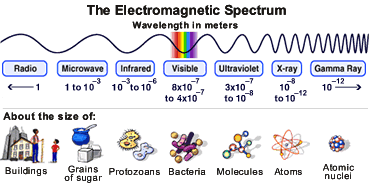 Visible light is but a very small part of the electromagnetic spectrum. Moving from visible light to longer wavelengths and lower frequencies we find infrared (keeps food warm at restaurants), microwaves (to warm your pizza pop) and radio (not the one streamed through the internet!).
Visible light is but a very small part of the electromagnetic spectrum. Moving from visible light to longer wavelengths and lower frequencies we find infrared (keeps food warm at restaurants), microwaves (to warm your pizza pop) and radio (not the one streamed through the internet!).
Now if you move in the opposite direction from visible light you find shorter wavelengths with higher frequencies starting with ultraviolet (what helps you get that summer tan), x-rays (word of the day), and finally gamma rays (topic for another day!). So x-rays are about the size of atoms and radio waves the size of buildings. Crazy. I think what is surprising is that with the naked eye we “see” so little and yet so much (philosophy anyone?).
So, x-rays are short wavelength, high frequency, high energy electromagnetic radiation that is able to penetrate some substances more easily than others. For example, they penetrate flesh more easily than bone, and bone more easily than lead. Thus they make it possible to see bones within flesh and a bullet embedded in bone. The ability of X rays to penetrate depends on their wavelength and on the density and thickness of the substance being scanned.
2- You have to use the word in a sentence by the end of the day. No need to use it in the correct context – actually out of context is more fun and elicits a more entertaining response!
Serious: Hey Frank, did you know the radiation you received during your chest x-ray last week was actually “soft” x-rays? Ones with shorter wavelengths and more penetrating power are used for scanning archaeological artifacts.
 Less serious: Frank! Dude, I got them! My x-ray specs just came in the mail. Let’s go the beach…
Less serious: Frank! Dude, I got them! My x-ray specs just came in the mail. Let’s go the beach…See you in the blogosphere,
Pascal Tyrrell
MiWord of the Day Is… Roentgen!
Welcome to the first Medical imaging Word of the Day! Here is how it works:
1- I introduce and discuss a word.
2- You have to use the word in a sentence by the end of the day. No need to use it in the correct context – actually out of context is more fun and elicits a more entertaining response!
OK, here we go. The word of the day is Roentgen – typically pronounced “Rent-gun”.
Wilhelm Roentgen was a physicist from northern Germany who in 1895 was the first to detect the now famous x-ray. Interestingly, he was not the first to produce them. The x-ray is part of the electromagnetic spectrum that contains shorter wavelengths (0.01 to 10 nm) than visible light (390-700 nm). We will talk about this in another post as today it is about Roentgen.
- Following his discovery the “Roentgen unit” was described and used to measure x-ray exposure (one R is 2.58×10−4 C/kg). About 500 R over 5 hours is considered a lethal dose for humans.
- Roentgen was the first scientist to receive the Nobel prize in physics in 1901. He refused to patent his discovery and gave the entire prize money to his university. Wow, what a guy!
- He died of colon cancer in 1923.
You like potato and I like potahto… Let’s Call the Whole Thing Off!
We have been talking about agreement lately (not sure what I am talking about? See the start of the series here) and we covered many terms that seem similar. Help!
Before you call the whole thing off and start dancing on roller skates like Fred Astaire and Ginger Roberts did in Shall We Dance, let’s clarify a little the difference between agreement and reliability.
When assessing agreement in medical research, we are often interested in one of three things:
1- comparing methods – à la Bland and Altman style.
2- validating an assay or analytical method.
3- assessing bioequivalence.
Agreement represents the degree of closeness between readings. We get that. Now reliability on the other hand actually assesses the degree of differentiation between subjects – so one’s ability to tell subjects apart from within a population. Yes, I realize this is a subtlety just as Ella Fitzgerald and Louis Armstrong sing about in the original Let’s Call the Whole Thing Off.
Now, often when assessing agreement one will use an unscaled index (ie a continuous measure for which you calculate the Mean Squared Deviation, Repeatability Standard Deviation, Reproducibility Standard Deviation, or the Bland and Altman Limits of Agreement) whereas when assessing reliability one often uses a scaled index (ie a measure for which you can calculate the Intraclass Correlation Coefficient or Concordance Correlation Coefficient). This is because a scaled index mostly depends on between-subject variability and, therefore, allows for the differentiation of subjects from a population.
Ok – clear as mud. Here are some very basic guidelines:
1- Use descriptive stats to start with.
2- Follow it up with an unscaled index measure like the MSD or LOI which deal with absolute values (like the difference).
3- Finish up with a scaled index measure that will yield a standardized value between -1 and +1 (like the ICC or CCC).
Potato, Potahtoe. Whatever.
Entertain yourself with this humorous clib from the Secret Policeman’s Ball and I’ll…
See you in the blogosphere!
Pascal Tyrrell
2 Legit 2 Quit
MC Hammer. Now those were interesting pants! Heard of the slang expression “Seems legit”? Well “legit” (short for legitimate) was popularized my MC Hammer’s song 2 Legit 2 Quit. I had blocked the memories of that video for many years. Painful – and no I never owned a pair of Hammer pants!

Whenever you sarcastically say “seems legit” you are suggesting that you question the validity of the finding. We have been talking about agreement lately and we have covered precision (see Repeat After Me), accuracy (see Men in Tights), and reliability (see Mr Reliable). Today let’s cover validity.
So, we have talked about how reliable a measure is under different circumstances and this helps us gauge its usefulness. However, do we know if what we are measuring is what we think it is. In other words, is it valid? Now reliability places an upper limit on validity – the higher the reliability, the higher the maximum possible validity. So random error will affect validity by reducing reliability whereas systematic error can directly affect validity – if there is a systematic shift of the new measurement from the reference or construct. When assessing validity we are interested in the proportion of the observed variance that reflects variance in the construct that the method was intended to measure.
***Too much stats alert*** Take a break and listen to Ice, Ice, Baby from the same era as MC Hammer and when you come back we will finish up with validity. Pants seem similar – agree? 🙂
OK, we’re back. The most challenging aspect of assessing validity is the terminology. There are several different types of validity dependent of the type of reference standard you decide to use (details to follow in later posts):
1- Content: the extent to which the measurement method assesses all the important content.
2- Construct: when measuring a hypothetical construct that may not be readily
observed.
3- Convergent: new measurement is correlated with other measurements of the same construct.
4- Discriminant: new measurement is not correlated with unrelated constructs.
So why do we assess validity? because we want to know the nature of what is being measured and the relationship of that measure to its scientific aim or purpose.
I’ll leave you with another “seem legit” picture that my kids would appreciate…
See you in the blogosphere,
Pascal Tyrrell
Mr Reliable
 |
| Kevin Durant is Mr Reliable |
Being reliable is an important and sought after trait in life. Kevin Durant has proven himself to be just that to the NBA. Would you agree (pun intended)? So, we have been talking about agreement lately and we have covered precision (see Repeat After Me) and accuracy (see Men in Tights). Today let’s talk a little about reliability.
See you in the blogosphere,
Pascal Tyrrell
Men in Tights?
One of the first movies my parents took me to see was Disney’s Robin Hood in 1973. This was back in the days when movies were viewed in theaters and TV was still black and white for most people. One of Robin’s most redeeming qualities is his prowess as an archer. He simply never misses his target. Well maybe not so much in Mel Brook’s rendition of Robin Hood Men in Tights!
We have been talking about agreement lately and last time we covered precision (see Repeat After Me). We discussed that precision is most often associated with random error around the expected measure. So, now you are thinking: how about the possibility of systematic error? You are right. Let’s take Robin Hood as an example. If he were to loose 3 arrows at a target and all of them were to land in the bulls-eye then you would say that he has good precision – all arrows were grouped together – and good accuracy as all arrows landed in the same ring. Accuracy is a measure of “trueness”. The least amount of bias without knowing the true value. Now if all 3 arrows landed in the same ring but in different areas of the target he would have good accuracy – all 3 arrows receive the same points for being in the same ring – but poor precision as they are not grouped together.
As agreement is a measure of “closeness” between readings, it is not surprising then that it is a broader term that contains both accuracy and precision. You are interested in how much random error is affecting your ability to measure something AND whether or not there also exists a systematic shift in the values of your measure. The first results in an increased level of background noise (variability) and the latter in the shift of the mean of your measures away from the truth. Both important when considering overall agreement.
OK, take a break and watch Shrek Robin Hood. The first of a series is always the best…
Now the concepts of accuracy and precision originated in the physical sciences. Not to be outdone, the social sciences decided to define their own terms of agreement – validity and reliability. We will discuss these next time after you listen to Bryan Adams – Everything I Do from the Robin Hood soundtrack. Great tune.
See you in the blogosphere,
Pascal Tyrrell

